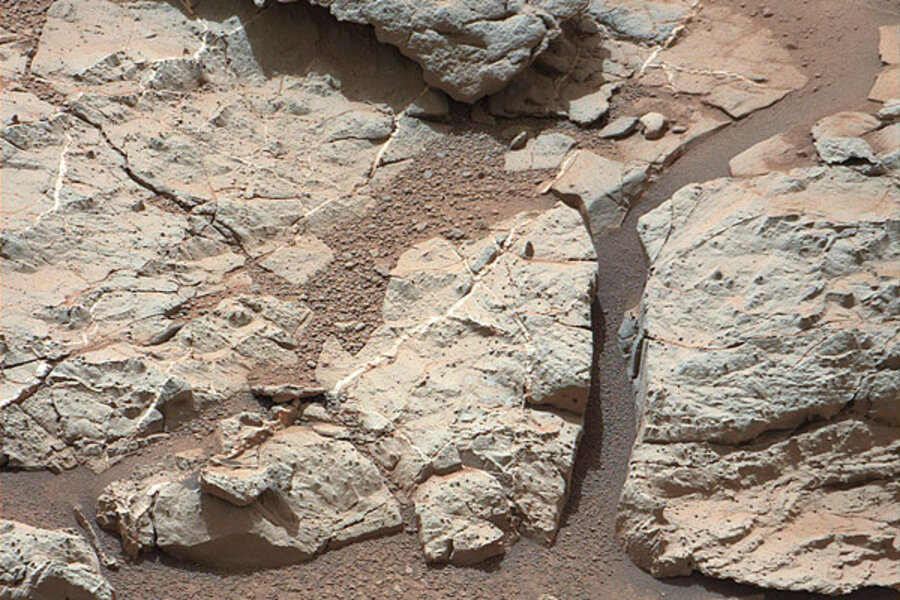White veins of Mars: Curiosity hits 'a jackpot' in quest for wetter past
Loading...
White veins of minerals coursing through rocks on the floor of Mars's Gale Crater are providing some of the strongest evidence yet that the rover Curiosity's landing site once was a wetter, warmer place.
The details are still fuzzy. But the composition of the minerals indicate that they precipitated out of water flowing through fissures in the rock, while large grains within the rocks themselves are rounded, suggesting that water might have dulled their sharp edges.
Yellowknife Bay, the rocky expanse Curiosity currently inhabits, "is literally shot through with these fractures," says John Grotzinger, a geologist at the California Institute of Technology in Pasadena., Calif., and the mission's chief scientist.
It also features abundant, berry-shaped spherules that scientists say are sedimentary concretions formed in and worked over by water.
All together, "basically these rocks were saturated with water," Dr. Grotzinger explained during a briefing Tuesday outlining the rover's latest exploits.
Yellowknife Bay represents "a jackpot unit," he added. Initially, researchers thought they might have to drive Curiosity up on the shoulders of Mt. Sharp, a towering summit in the middle of the crater, to find such a trove.
If Curiosity made these finds on Mt. Sharp, "we would have been absolutely thrilled," Grotzinger says.
Curiosity, a one-ton geochemistry lab on wheels, landed on Mars in August. Its goal is to see if the crater at one time could have been hospitable for simple forms of organic life. Curiosity has spent the past six months exercising its suite of 10 instruments and its seven-foot robotic arm in a series of tests aimed at ensuring all the hardware is working well before the rover heads for Mt. Sharp, its ultimate destination.
The rover probably won't begin to explore Mt. Sharp for another year.
Curiosity has traveled slightly more than a quarter of a mile, as the crow flies, since landing. Along the way, however, scientists have chosen targets for instrument tests that have already provided insights into the crater's geologic past – including evidence for an ancient stream bed.
Yellowknife Bay, a portion of a larger feature the team dubbed Glenelg, is the lowest, hence oldest, formation the rover has explored. It hosts a number of clues that point to a watery past. [Editor's note: The original version of this paragraph gave an incorrect relative age for the Yellowknife Bay formation.]
- Using the equivalent of a geologist's magnifying glass on the end of the the robotic arm, researchers identified a wide variety of rock textures. These range "from conglomerate to sandstone to siltstone" and all "are sedimentary rocks, meaning that other rocks had to be broken down into fragments and transported elsewhere," says Aileen Yingst, a researcher with the Planetary Science Institute in Tucson and deputy principle investigator for the robotic hand lens, known as MAHLI. How were they transported? Many of the fragments are too big to have traveled on the Martian wind, suggesting water.
- A layered, rock outcrop the team has named the Shaler Unit indicates a stream flowed through the area, shifting small sediment dunes on the stream bed in ways that formed the layers.
- The composition of the white minerals in rock veins is consistent with calcium sulfate, plus a fair bit of hydrogen. The relatively high levels of hydrogen suggest the minerals precipitated out of water flowing through the fissures.
The mineral-filled fissures looked similar to those found in rocks in the Sahara, says Nicolas Mangold, a researcher with the Laboratoire de Planétologie et Géodynamique de Nantes in France and a member of the Curiosity rover's ChemCam team. Those desert veins were formed when water circulated through the cracks.
Given the conditions under which calcium sulfate forms on Earth, he suggests the veins on Mars formed at low to moderate temperatures.
The estimate hints at why the team is excited not just to have found evidence of water, but water that bears the raw material for precipitation of minerals. Like sedimentary rocks, minerals are made of bits and pieces from somewhere else – in this case from ions released from rock somewhere else as water flowed over or through it. And different minerals precipitate out at different temperatures, yielding some information about the environment at the time the minerals formed.
As Curiosity explores Yellowknife Bay, it will undergo its last test – using a drill at the end of its arm to extract the first drill samples. Those samples will be used to clean the delivery system the drill uses to transfer the samples to a pair of chemistry labs inside Curiosity's chassis. Once the cleaning ends, the drill will provide samples to the labs for analysis.
Researchers have selected a rock named for the late John Klein, Curiosity's former deputy project manager, who passed away in 2011. Drilling should begin within the next two weeks.







